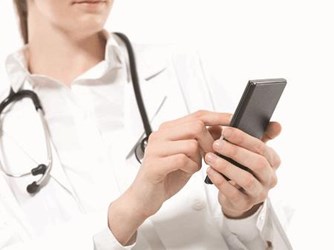Applying Next-Level Technology Across Mobile Healthcare Operations
By Mark Percy, VP of Technology at Field Squared

It wasn’t all that long ago in the world of mobile healthcare where caregivers made rounds using a pen and clipboard. Paper-based health forms, checklists and aide plans were the norm. Today, as healthcare providers seek to maintain increasingly strict patient visit times, paper no longer works.
In fact, healthcare technology—from medical devices to mobile healthcare software—is one of the fastest growing business sectors.
Beyond the healthcare facility walls, enabling mobile caregivers is, arguably, as important as the visit itself. A tablet on the arm of every field nurse conducting remote patient visits, pre-loaded with a mobile field service application that is HIPAA compliant, is great start.
What follows are three quick ways to apply next-level technology to improve mobile healthcare service operations.
Automate Status Alerts and Patient Notifications
The seemingly ubiquitous text message has shifted over the past few years as a means for businesses to keep customers apprised of visits and on-site service work updates. Today, before a caregiver arrives at the patient’s house, most likely the customer has already received a few forms of communication about the visit.
This may seem like a natural progression from text messages, but it might surprise even the most technologically astute to know that notifications are not ubiquitous when it comes to methods of mobile healthcare communication.
In healthcare, adoption lags behind that of other industries even when studies have shown an improved outcome of as much as 77% may be realized through the use of SMS (Source: NIH, Use of Mobile Phone Text Message Reminders in Health Care Services: A Narrative Literature Review).
Mobile healthcare software providers like Field Squared that come pre-packaged with automated notification capabilities, including patient reminders for visits, health checks and other activities, ensure healthcare providers and caregivers are in constant communication before, during and after each visit.
Given the title of this article, another way to level-up mobile healthcare service operations is through the integration of third-party systems, such as accounting solutions, to further automate end-to-end payment collection or insurance billing processes. After all, realizing revenue faster is a goal for many healthcare provider organizations, especially today.
Go Mobile and Offline Capable with Aide Plans, Health Forms and Checklists
To say there is an overabundance of paperwork in the healthcare field would be an understatement. For good reason, everything is documented. Mobile devices have been a timesaver, as well as a tree saver, over the past few years. Especially for mobile caregivers, paper-based processes do not hold up to their mobile device alternative.
That is where mobile forms come into play. The varied nature of mobile healthcare service work means a change in strategy from one patience visit to the next. Keeping track of everything should not take five different systems.
Mobile forms for such activities as aide plans, health checkups and medical consent forms, are a quick way to truly level-up mobile healthcare service operations. Not only do mobile forms save time, they significantly cut down on data inaccuracies. At Field Squared, we have seen as much as a 90% improvement in field data accuracy through the use of our mobile forms across various industries that use our field service management automation software.
There are times when cellular or WiFi connectivity can be a challenge in the field. Truly remote areas may have no cellular reception whatsoever. One way to combat this is with an offline capable field service mobile application. Activity is still tracked—mobile forms are still fully functional—and all data is synced when connectivity is restored.
Visibility on a Live Map to Dispatch and Schedule Visits
Planning mobile healthcare visits is another key area where technology can take operations management to the next level. Scheduling software is a part of the puzzle that makes it possible to help increase productivity.
The real game-changer is visibility into, not only visits that are scheduled, but visits that are in a backlog or not yet scheduled.
Picture a map that surfaces the current location of caregivers, visits not yet scheduled, as well as territory boundaries. Visually, it is much easier to see the full picture of mobile field operations.
The best technology provides methods to quickly dispatch a caregiver to a visit, such as selecting an unscheduled job on the map to select between options like “assign nearest” or “assign next available.”
To truly take scheduling to the next level, is when planning a week of scheduled visits, for example. In that case, using route optimization software takes the guesswork out of the process and lets the software do the manual work.
The result is an optimized plan that frees up time for the operations team, or, in many cases, the director of nursing, to focus on higher priority projects.
It is amazing what three ways to apply next-level technology across mobile healthcare operations can have such an impact. The differences between yesterday’s manual processes have paved the way for today’s time-saving technology to come into their own. Investing now is a way to future proof operations over the coming years to remain competitive, while improving the customer experience.
